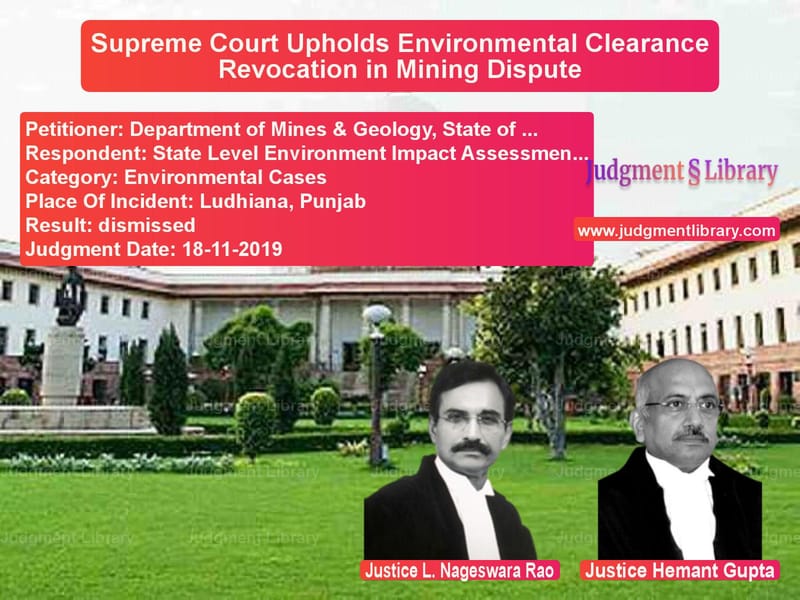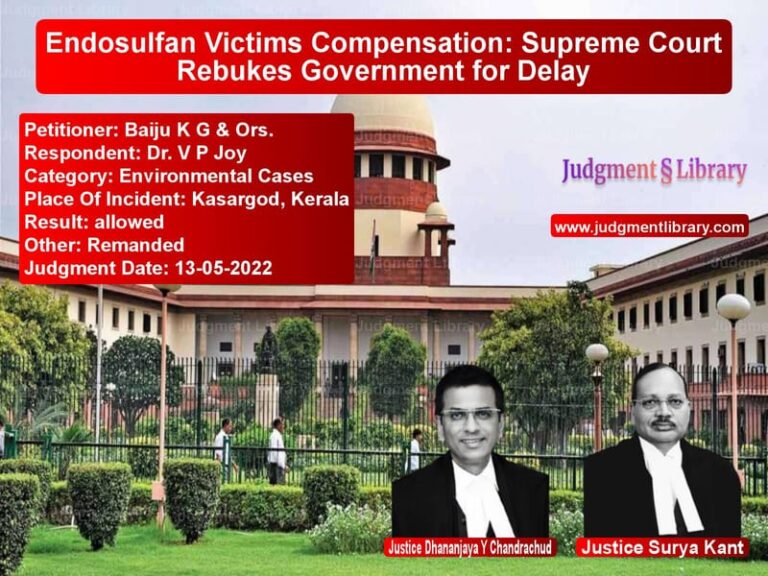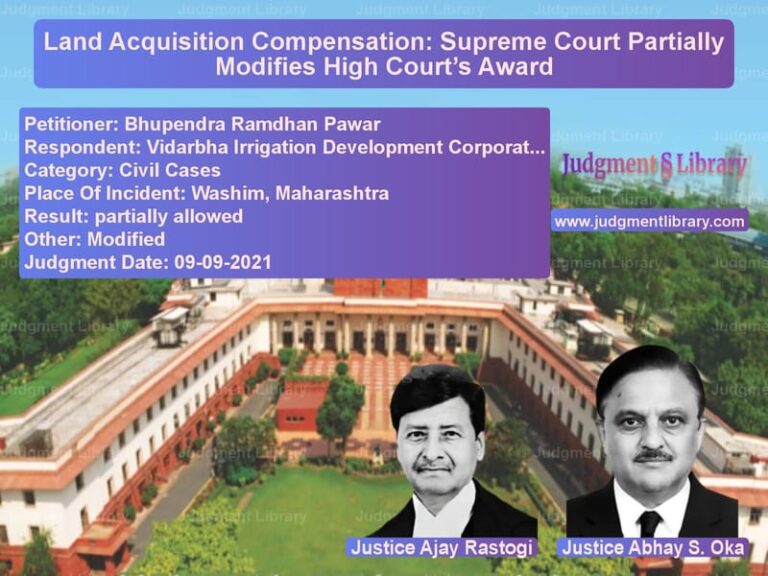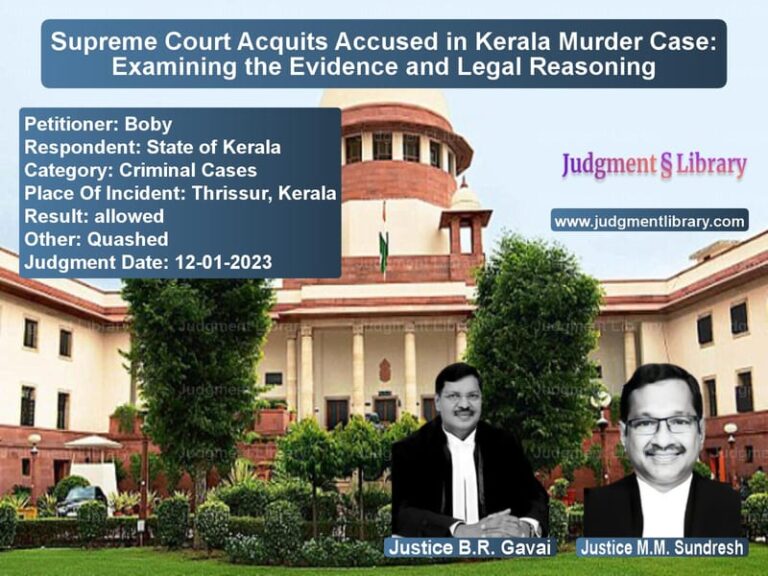Supreme Court Upholds Environmental Clearance Revocation in Mining Dispute
The Supreme Court of India, in its judgment dated November 18, 2019, ruled in the case of Department of Mines & Geology, State of Punjab vs. State Level Environment Impact Assessment Authority, Punjab. This case revolved around the revocation of environmental clearance for mining operations in the state of Punjab. The ruling sets an important precedent for environmental law, particularly in cases concerning the misrepresentation of facts in environmental clearance applications.
Background of the Case
The case originated when the Department of Mines & Geology, State of Punjab, sought environmental clearance under the Environment Impact Assessment (EIA) Notification dated September 14, 2006, for mining minor minerals (sand) in an area of 12.96 hectares in the revenue estate of village Heatewal, Tehsil Jagraon, District Ludhiana. The appellant submitted the required documents, including:
- Form-I
- Pre-feasibility report
- Proof of ownership of land
- Approved mining plan
- No Objection Certificate (NOC) from the concerned District Forest Officer
- Final District Survey Report
- Environmental management plan
Based on the submitted documents, the State Expert Appraisal Committee (SEAC) granted environmental clearance on May 3, 2017, allowing the mining operations to proceed.
Dispute Arising from the Environmental Clearance
After obtaining environmental clearance, the appellant issued notices dated May 3, 2017, and June 13, 2017, indicating the intention to put up 102 minor mineral mines for auction. Upon completion of the auction, the appellant applied to the State Level Environment Impact Assessment Authority (SEIAA), Punjab, for the transfer of the mining environmental clearances to the successful bidders.
The SEIAA reviewed the application in its 125th meeting held on January 12, 2018, and identified discrepancies in the appellant’s initial submissions:
- Several Khasra numbers (land parcels) were found to be located in a stream, whereas, at the time of filing the application, the appellant had claimed that all Khasra numbers were in the riverbed of the Sutlej River and away from the active channel.
- Some Khasra numbers were found to be located in agricultural land, indicating that no replenishment of minerals would be available.
Revocation of Environmental Clearance
Based on these findings, the SEIAA issued a show-cause notice to the appellant, questioning why the granted environmental clearance should not be revoked. The appellant responded, but SEIAA found the explanation insufficient and, on April 9, 2018, revoked the previously granted environmental clearance.
Appeal Before the National Green Tribunal (NGT)
Aggrieved by the revocation, the appellant challenged the SEIAA’s decision before the National Green Tribunal (NGT), Principal Bench, New Delhi. However, the NGT dismissed the appeal and upheld the SEIAA’s decision. The NGT reasoned that:
- The revocation was preceded by an inspection report conducted by a committee constituted by the Sub-Divisional Magistrate, Jagraon, on December 12, 2017.
- The committee conducted an on-site verification on December 13, 2017, and found that the appellant had misrepresented facts in its original environmental clearance application.
- The joint demarcation report confirmed that most of the land was under flood protection bundhs/spurs and that parts of the land were private agricultural plots, making mineral replenishment unlikely.
Appeal Before the Supreme Court
The Department of Mines & Geology, State of Punjab, further appealed against the NGT’s order before the Supreme Court, arguing that:
- The mining lease area was clearly identified as part of the riverbed in the environmental clearance application.
- The pre-feasibility report stated that mining activities would be restricted to dry parts of the riverbed.
- The excavation site would replenish naturally every monsoon season, thereby ensuring minimal environmental impact.
The SEIAA countered these arguments, pointing out that:
- The ground verification by independent agencies proved that several Khasra numbers were in a stream and not in a dry riverbed.
- The appellant had failed to disclose that some mining sites were in agricultural land, which contradicts the environmental clearance conditions.
Supreme Court’s Observations
After reviewing the material on record and the submissions made by the parties, the Supreme Court made the following observations:
- The revocation of the environmental clearance was based on conclusive evidence that the appellant had misrepresented the nature of the mining sites.
- The joint inspection report by the Revenue and Mining Departments established that several Khasra numbers were wrongly identified in the original application.
- The revocation was carried out in adherence to due process, and the NGT had rightly refused to interfere with the SEIAA’s findings.
Final Judgment
The Supreme Court upheld the decisions of both the SEIAA and the NGT, ruling that:
- The appellant had failed to provide an accurate representation of the mining sites in its environmental clearance application.
- The revocation of the environmental clearance was justified based on material discrepancies.
- The appellant was, however, allowed to file a fresh application for environmental clearance, which would be considered on its own merits.
Impact of the Judgment
- Reinforces Due Diligence: The ruling ensures that mining applications undergo stringent verification before environmental clearance is granted.
- Prevents Environmental Misrepresentation: The decision deters misrepresentation of land use in environmental clearance applications.
- Sets a Precedent for Future Cases: The judgment strengthens regulatory compliance for environmental clearances in mining operations.
Conclusion
The Supreme Court’s ruling in Department of Mines & Geology, State of Punjab vs. State Level Environment Impact Assessment Authority, Punjab sets a crucial precedent for environmental law and regulatory oversight in India. It upholds the importance of due diligence in environmental clearance processes and ensures accountability in mining operations.
Petitioner Name: Department of Mines & Geology, State of Punjab.Respondent Name: State Level Environment Impact Assessment Authority, Punjab.Judgment By: Justice L. Nageswara Rao, Justice Hemant Gupta.Place Of Incident: Ludhiana, Punjab.Judgment Date: 18-11-2019.
Don’t miss out on the full details! Download the complete judgment in PDF format below and gain valuable insights instantly!
Download Judgment: Department of Mines vs State Level Environm Supreme Court of India Judgment Dated 18-11-2019.pdf
Direct Downlaod Judgment: Direct downlaod this Judgment
See all petitions in Environmental Cases
See all petitions in Public Interest Litigation
See all petitions in Fundamental Rights
See all petitions in Judgment by L. Nageswara Rao
See all petitions in Judgment by Hemant Gupta
See all petitions in dismissed
See all petitions in supreme court of India judgments November 2019
See all petitions in 2019 judgments
See all posts in Environmental Cases Category
See all allowed petitions in Environmental Cases Category
See all Dismissed petitions in Environmental Cases Category
See all partially allowed petitions in Environmental Cases Category







